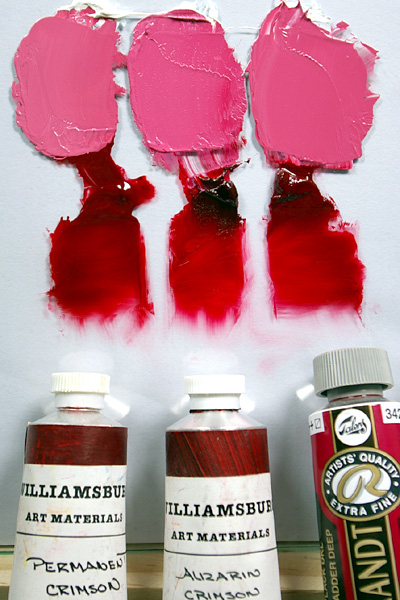
I finally decided to replace my Alizarin Crimson, which is only moderately lightfast (not that I ever really use it by itself in thin layers). I love the Alizarin by Williamsburg (dihydroxyanthraquinone, PR 83) and wanted to give their substitute a chance as I now go with them for all but one of my palette colors, so I tried their Permanent Crimson (anthraquinone, PR 177), which is described as an "absolutely permanent, lightfast substitute for Alizarin Crimson." Very disappointingly, Gamblin's Alizarin Permanent is made from a mixture of quinacridone red b (PV 19), perylene red (PR 149), and ultramarine (PB 29), so I'm not bothering with that. I read recently in at least three places that a truer substitute for the traditional Alizarin or madder hue is pyrrole ruby pigment (PR 264), which can be found in Rembrandt's Permanent Madder Deep (among others), so I got a tube to check it out.
Here I mixed a tint of each one with titanium white. I was afraid a photo would flatten any hue difference between the pigments, but except for the Permanent Crimson which seemed the tiniest bit warmer (this would create slightly less purple purples if you know what I mean), there was little hue difference for the camera to flatten. And all three pigments are strong-staining and have that lovely pinkish undertone. In masstone, however, the substitutes clearly don't match the Alizarin, in center, which is beautifully deep and dark as a thick pile (it almost resembles here a bleeding scab). The substitute Williamsburg, at left, feels flat, with little difference between its masstone and undertone. The Rembrandt pigment, while not an exact match, shows at least some of that Alizarin-like deepening as it gets thicker. Such deepness might not factor much in my normal painting work but it was something I was happy to see, so for this along with its excellent berry-juice-like quality overall, I'm going to try using the Permanent Madder Deep as my Alizarin substitute.
Friday, October 3, 2008
A Lightfast Alizarin
Posted by
Dan P. Carr
at
1:46 AM
![]()
Tags: materials, miscellanea, palette
Subscribe to:
Post Comments (Atom)



6 comments:
I'm a big fan of Robert Doak's Pyrol Ruby, which is not exactly the same as alizarin, but does everything I need it to do.
Thanks David (I'm a big fan of your blog) - I will have to give Doak a try soon.
I use WB's Permanent Crimson and I just bought some Florentine Lake from
Blue Ridge paint which I like a lot of a substitute for alizarin.
If you go to the forum Rational Painting http://www.rationalpainting.org
there is an interesting discussion about Doak's paint some major issues that have started to come up.
These are serious enough for some painters who are thinking of dumping all their Doak stock.
Thanks Jeff for the link, I just signed up. I have read here and there about some weirdness in Doak (the paint, not the man) but these are some real horror stories. Happy halloween.
Thanks for posting this, Dan - now I don't have to go out and buy these "other alizarins" myself! Since I usually do watercolors, I treat my work like everything is fugitive, but I have picked up some oils recently and they've been taunting me from the bin...
When I was applying for a loan to purchase my building as a small business owner in a tough situation, conventional banks said they could not help me. Mr Pedro, a loan officer, sat down with me, heard my situation and decided that I was worth taking a chance on. Here we are 3 years later and I have just renewed my loan for another 7 years. I couldn’t have purchased my building without the help of Mr Pedro and will be forever indebted to them for giving me a chance when no one else would."
I will recommend you to contact a loan officer Mr Pedro on the information below if you need any financial assistance.Email & Chat: +1 863 231 0632 pedroloanss@gmail.com
Post a Comment